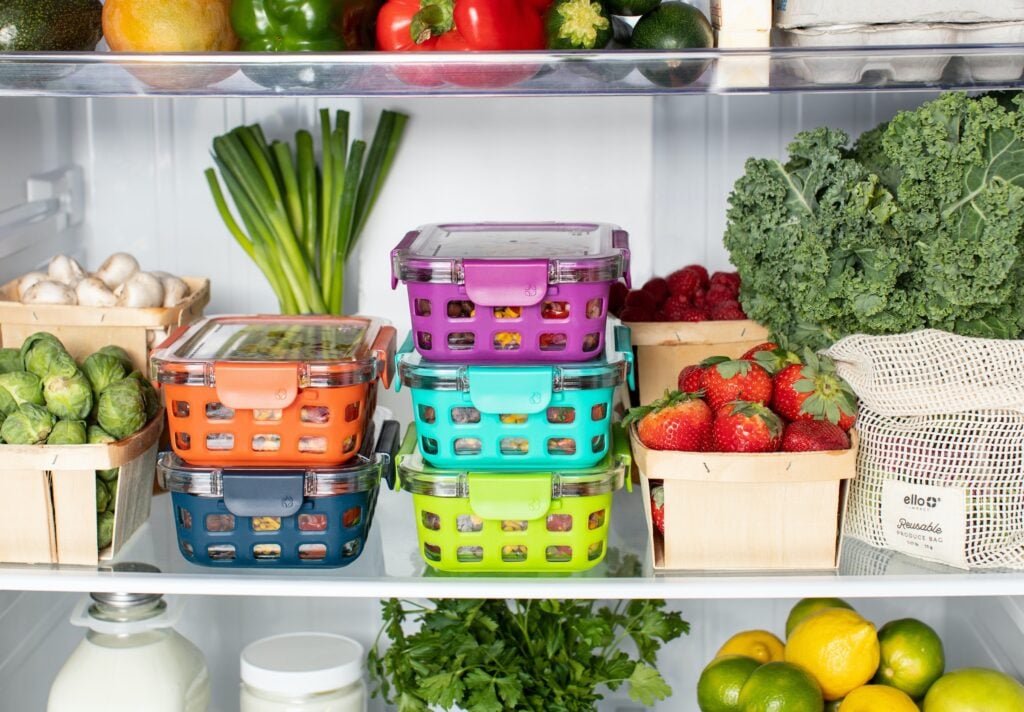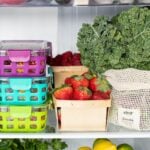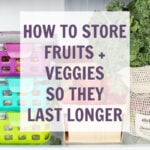How to Store Fruits and Vegetables So They Last Longer (Plastic-Free)
Ahhh… that hopeful feeling you get after buying fresh produce or picking up your weekly CSA goodies.
Ugh… the misery of finding unused, withered, moldy veggies in the crisper.
To help us all avoid that disappointment and waste, here’s a complete guide on how to store fruits and vegetables without plastic so they last longer.

Whether you’re planning your weekly meals or getting prepared for power outages or emergencies, proper food storage is a useful skill. In the end, storing food properly will keep it usable and fresh for as long as possible.
Table of contents
When it comes to food storage, we try to avoid plastic. There are plenty of zero waste ways to use jars, reusable cloth bags, mesh bags, or glass or silicone containers. Paper bags and cartons work, too. And if you must opt for plastic, be sure to wash and reuse when possible. Stackable glass storage containers are our favorites for sliced veggies/fruits and for leftovers because you can actually SEE what you have.
Start With a Plan
One of the best ways to make sure you don’t waste food is to create a plan. Whether you’re a gardener who has to plan ahead for harvesting and preserving or just trying to keep yourself (and your family) fed for a week, a plan is essential.
Once you learn the basics of meal planning it’s simple to follow. If all that structure is not your family’s style, you don’t have to assign meals to certain days. Just list 5 days of meals and make them when you feel like it.
Another way to have a little freedom with your meal planning is to assign each night a theme. Taco Tuesday is pretty specific, but Italian on Friday leaves room for pizza night, pasta, etc. One meal can be leftovers or “use up what’s about to go bad” night.
How to Store Fresh Fruits and Vegetables
Here are our tips for avoiding plastic storage and getting the most out of your fresh foods.
Wash and Dry Thoroughly
Rinse foods carefully to make sure there is no dirt, mud, or other plants and bugs in the bundle.
Dry them by swaddling in a tea towel, paper towels, or use a salad spinner. Traces of humidity can help keep some fruits and veggies fresh. But too much moisture can cause softening or mold.
If your fruit, like tomatoes, is almost ripe, leave it at room temperature to reach the height of its ripening process. Only once the fruit or vegetable is ripe should you proceed to store it in the fridge, freezer, cellar, pantry, or other designated storage area.
How to Store Vegetables in the Fridge Without Plastic
Here’s a list of how and where to store most of your fresh foods without using plastic.
Fresh Greens
Line the crisper drawer with a fresh dish towel (change it every few days). In humid climates, greens like lettuce, spinach, and arugula last a little longer in an organic canvas produce bag.
Apples and Pears
If they came in a plastic bag, keep them in it in the fridge. Or use the crisper drawer you’ve designated for non-ethylene-sensitive fruit, such as strawberries, blueberries, navel oranges, and raspberries. (source)
Berries
Wash berries in a mix of vinegar and water to help prevent molding. Dry thoroughly and then store berries in a container lined with paper or cloth towels with the lid slightly open. Or try any of the above and store them in a mason jar with the lid closed. This one has its own hashtag on social media – #strawberryhack.
Another popular social media hack is to wash berries, spray with colloidal silver, let dry fully, and refrigerate. People claim to get an extra week to two weeks with this trick.
Carrots
Peel and cut carrots then store in a mason jar of water in the fridge. We’ve tried it and it makes them last at least twice as long as keeping them in the bag they came in.
Green Onions
Place with stems down in a mason jar of water (with no lid) in the fridge.
Citrus
Citrus fruit stays firm and juicy longer when kept in the fridge.
Hard Squashes
Summer squash (zucchini and the one we all call yellow squash) should be stored in the fridge, but thick-skinned squash like acorn or butternut are fine kept at room temperature.
Mushrooms
Store mushrooms in the refrigerator (or somewhere very cool), in their original package or in a paper bag.
Pineapple
Pineapples don’t ripen after picking, so make plans to eat it within a few days of buying. They’re fine (and pretty) to sit out on the counter and won’t take up valuable space in the fridge. *Green Child’s editor was told by someone in the Caribbean that standing a pineapple up suffocates it, so you should always store it on its side.
Cabbage
When uncut, refrigerate in the crisper drawer or a canvas bag. Once cut, seal in an airtight container.
Melons
Changing the temperature of the melon creates interior tension, which can affect the taste and texture. This is a personal preference, but you don’t have to store melon in the fridge.
Herbs
Store herbs in the refrigerator, swaddled in a damp cloth towel. Or store them stems-down in a jar partly filled with water at room temperature or in the refrigerator. Basil is best left out of the fridge and used as quickly as possible.
How to Store Foods That Don’t Have to Be Refrigerated
Avocados
Not-yet-ripe avocados belong on the counter. Keep them away from other countertop fruits and vegetables as they produce ethylene gas which can cause other foods to ripen faster.
Bananas
Bananas are picked green and will continue to ripen if you keep them out of the fridge. Experiments have shown that bananas left attached in a bunch will ripen more slowly than when they’re separated. A bamboo hanger is a great way to keep air circulating around the bananas and prevent bruising in a bowl. You can refrigerate once they’re ripe if you want to make them last longer.
Tomatoes
Keep tomatoes on the counter. A counter near a window is an ideal spot so they can ripen to perfection in the sunlight.
Garlic & Onions
With the exception of spring onions and scallions, alliums shouldn’t be kept in the fridge. Like potatoes, these bulbs are best kept in a cool, dry, dark place. And they need to breathe, so don’t wrap them in plastic bags.
Potatoes and Sweet Potatoes
Store your starchy vegetables in a cool, dry, dark place to keep them from sprouting (caused by sunlight and moisture).
Stone Fruit
Plums, peaches, and cherries are similar to tomatoes in that the fridge can make their flesh go mealy. They stay juicy and delicious when left out on the counter.
General Food Storage Tips
Store in Fridge
Refrigerating tends to pause the ripening process of many foods. In the fridge, your vegetables and fruits can be stored from one day to two weeks, depending on their ripeness and type. Eventually, if not stored correctly or left too long to wither, all food will go to waste. Also, a refrigerator is not a suitable location to store food in emergencies, since it won’t keep foods cold without power.
Transfer to Freezer
You can store your dry ripe veggies and fruits in the freezer, too. This way, your food will be frozen and can last much longer. So, if you can’t eat your fruit right away, freeze it.
You can leave most fresh food frozen for up to 6 months. The only downside to this long-term storage option is that it only works with electricity.
Store in Pantry or Root Cellar
You can also store your fruits and vegetables in your pantry or root cellar. These dry and dark places are perfect for onions, apples, and potatoes. You can use this storage space for as long as six months, depending on the humidity.
Pantries, root cellars, and dark cupboards can be used without energy. So if you find yourself in a situation where there is no energy, or if electricity is scarce, you know where to store the appropriate food items.
Canning Fruit and Vegetables
Another practical way to store food or make it last longer is canning. Unlike the other options, canning requires more knowledge, time, and skills.
But it pays off to have canned food that will not go bad even in an emergency, where store-bought cans are not accessible. After you are done with canning, make sure to properly store your jars in the pantry. Except for canning, you can also dehydrate, pickle or ferment your food.
Best Ways to Avoid Food Waste
After going through our guide on easy food storage, we have put together some tips that you can use when storing food, regardless if it’s your freezer, refrigerator, root cellar, or pantry. Here are our tips:
- Use if soft: If leafy greens or peppers start to turn soft, you need to act. Use them in cooking as soon as possible, or they will go to waste.
- Know your fridge: If you want to store produce for as long as possible, you need to know which parts of your fridge are the coldest. Mostly, the middle of your fridge is best for herbs.
- Use rodent proof storage: If you don’t want to keep your produce in the fridge, make sure your cellar or storage room doesn’t have any rodents. In a time of crisis, rodent infestation poses the worst threat to humans.
- Leave space for air to circulate: Regardless if you’re storing in the freezer, cellar, or refrigerator, make sure your veggies don’t touch. If you leave no air between produce, they are more prone to growing mold.
- Research shelf life: Knowing how and where to store fruits and veggies is a must for prolonged life. Therefore, you need to do your research and see how long each food can stay at room temperature, and how long in the fridge or freezer.


